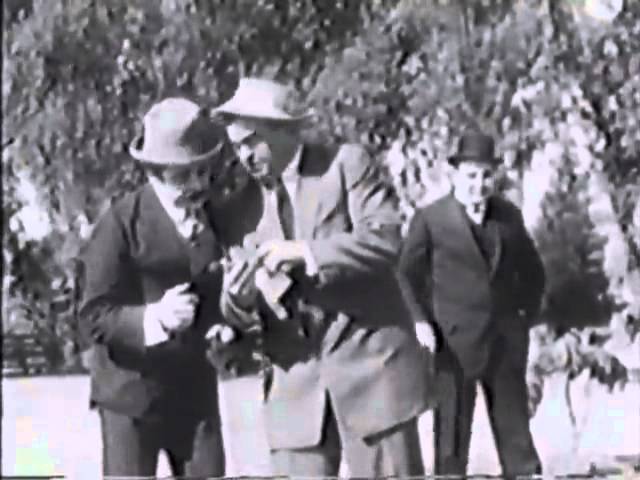Dr. Peg Lamphier and Dr. Rosanne Welch present their talk, “Why this should be the last lecture you should sit through!” as part of the Last Lecture Series at Cal Poly Pomona.
Complete video of this Talk coming soon.
On Screenwriting and Media with Dr. Rosanne Welch
Writing, Film, Television and More!
Dr. Peg Lamphier and Dr. Rosanne Welch present their talk, “Why this should be the last lecture you should sit through!” as part of the Last Lecture Series at Cal Poly Pomona.
Complete video of this Talk coming soon.
Complete video of this Talk coming soon.
A History of Screenwriting 48 – The Engagement Ring – Mabel Normand – 1912 
Alice has two persistent suitors, one rich, one poor. Each buys her an engagement ring; the rich man pays cash, but the poor man must pay on installments. He has trouble making the payments, but then he’s injured in an auto accident and the settlement allows him to pay off the ring and propose to Alice.
Learn More About Mabel Normand with these books †
* A portion of each sale from Amazon.com directly supports our blogs ** Many of these books may be available from your local library. Check it out! † Available at the LA Public Library
Watch this entire presentation
A recording of my presentation at this year’s University Film and Video Association (UFVA) 2017 conference.
Transcript:
In Beauchamp’s book, you’ll see all these famous women. My great joy is that one of my students, who teaches directing, found Lois Weber in my class who wrote and directed her films back in the day and now incorporates her into the set of directors that he teaches as examples because she had that kind of career back in the day. Eve Unsell ran her own production company for Universal for 10 years. Made a ton of movies that are very very successful in the day. She also allows us to go into the place where we discuss the problems with films whether it is back them or today because she was involved in what, back then, were yellow race films which were anti-Asian-American films and so that’s something students should understand about. So, again that goes back to to the title of what we are talking about and I talk fast because I’m Sicilian. I also don’t want to eat up all the time.
Books Mentioned In This Presentation
Follow Dr. Rosanne Welch
Twitter: https://twitter.com/rosannewelch
Instagram: https://www.instagram.com/drrosannewelch/
Podcast: Play in new window | Download
Subscribe: RSS
Watch this entire presentation
A recording of my presentation at this year’s University Film and Video Association (UFVA) 2017 conference.
Transcript:
So I teach history and I start in the silent film world, so I disagree with Warren. I go chronologically. This is a period they have never heard of and all the movies are free on YouTube. Nothing like telling them they can watch whatever they have to watch for free. That works, right? And so here they meet Anita Loos, Gene Gauntier — the first women — the first person to do filming on location. She went to Jerusalem to film the story of Jesus Christ — the first time it was put on film and it’s a really beautiful film you can see, for free, on YouTube. Then Jeanie MacPherson who wrote all of Cecil B. DeMille’s early movies that were successes. When she stopped working for him all his stuff failed. Nobody knows her name and she’s quite brilliant. So I thinks it’s important for women students today to know that women once ran Hollywood so all this discussion about “I don’t know if women should direct a movie” is not worth having, because they did and they were. They were the highest paid people in this town, so I think that’s important an important think for them to remember.
Books Mentioned In This Presentation
Follow Dr. Rosanne Welch
Twitter: https://twitter.com/rosannewelch
Instagram: https://www.instagram.com/drrosannewelch/
Podcast: Play in new window | Download
Subscribe: RSS
Sense and Sensibility: The Screenplay and Diaries | Gifts for the Screenwriter #3
For me this on set diary by a writer who also starred in the film and had to make script changes in the evenings after a full day of filming is a wonderful look at the real life of working writer/performer. The bonus fact iis that it is written by Emma Thompson about her work on Sense and Sensibility – a most marvelous movie to view and study.
* A portion of each sale from Amazon.com directly supports our blogs
My co-editor Peg Lamphier and I were happy to see the newly designed covers for our next 3 Volume encyclopedia – Technical Innovation in American History. Thanks to all the wonderful contributors who came over from our encylcopedia on Women in American History
Look for it in 2019!
From ABC-CLIO…
Technical Innovation in American History: An Encyclopedia of Science and Technology surveys the history of technology, documenting the chronological and thematic connections between specific inventions, technological systems, individuals, and events that have contributed to the history of science and technology in the United States. Covering eras from colonial times to the present day in three chronological volumes, the entries include innovations in fields such as architecture, civil engineering, transportation, energy, mining and oil industries, chemical industries, electronics, computer and information technology, communications (television, radio, and print), agriculture and food technology, and military technology.
The A–Z entries address key individuals, events, organizations, and legislation related to themes such as industry, consumer and medical technology, military technology, computer technology, and space science, among others, enabling readers to understand how specific inventions, technological systems, individuals, and events influenced the history, cultural development, and even self-identity of the United States and its people. The information also spotlights how American culture, the U.S. government, and American society have specifically influenced technological development.